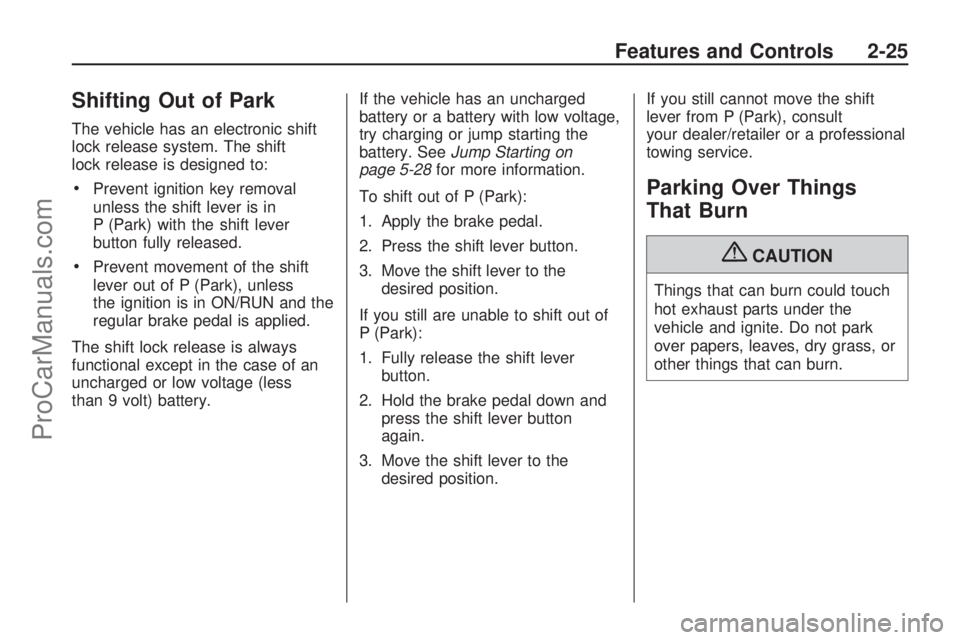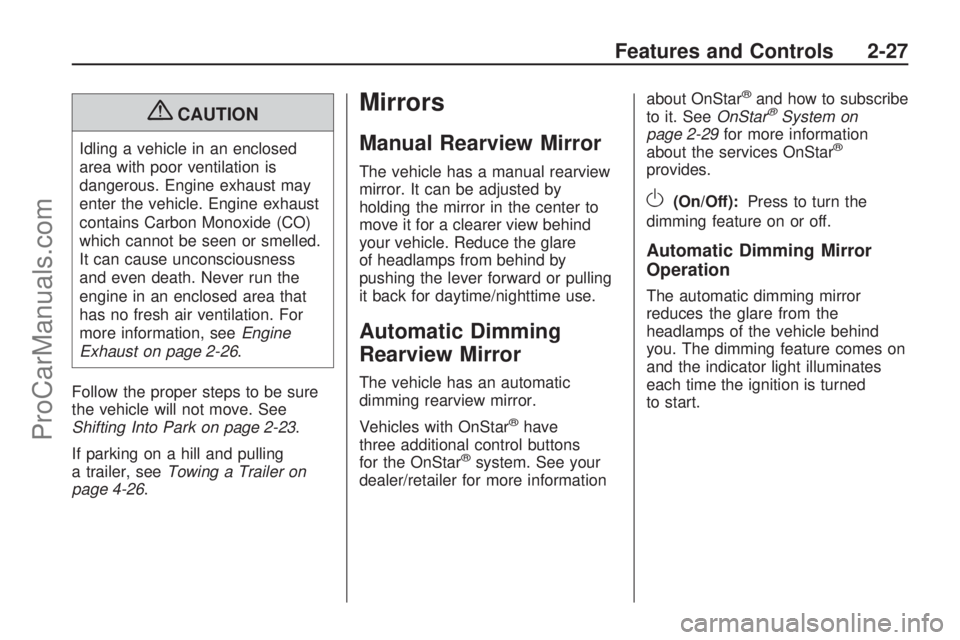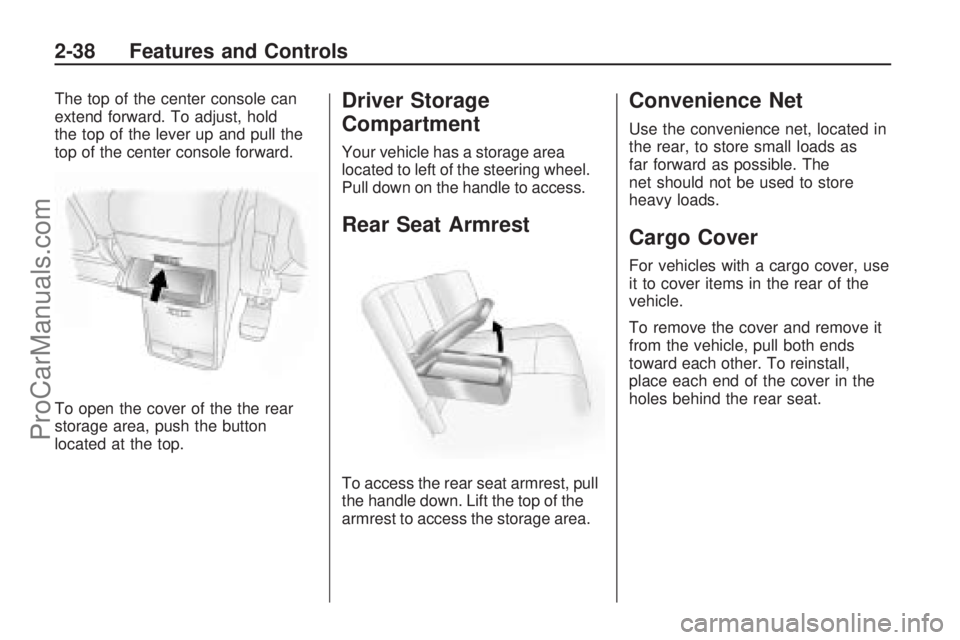tow SATURN VUE HYBRID 2009 User Guide
[x] Cancel search | Manufacturer: SATURN, Model Year: 2009, Model line: VUE HYBRID, Model: SATURN VUE HYBRID 2009Pages: 346, PDF Size: 2.1 MB
Page 76 of 346

Starting and
Operating Your
Vehicle
New Vehicle Break-In
Notice:The vehicle does
not need an elaborate break-in.
But it will perform better in
the long run if you follow these
guidelines:
Do not drive at any one
constant speed, fast or slow,
for the �rst 500 miles (805 km).
Do not make full-throttle
starts. Avoid downshifting to
brake or slow the vehicle.
Avoid making hard stops for
the �rst 200 miles (322 km)
or so. During this time the
new brake linings are not yet
broken in. Hard stops with new
linings can mean premature
wear and earlier replacement.
Follow this breaking-in
guideline every time you
get new brake linings.
Do not tow a trailer during
break-in. SeeTowing a
Trailer on page 4-26for the
trailer towing capabilities
of your vehicle and more
information.
Following break-in, engine speed
and load can be gradually
increased.
Ignition Positions
The ignition switch has four different
positions.To shift out of P (Park), turn the
ignition to ON/RUN and apply
the regular brake pedal.
Notice:Using a tool to force the
key to turn in the ignition could
cause damage to the switch
or break the key. Use the correct
key, make sure it is all the
way in, and turn it only with
your hand. If the key cannot be
turned by hand, see your
dealer/retailer.
LOCK/OFF:This position locks the
ignition. It also locks the steering
wheel and the transmission. The key
can only be removed in LOCK/OFF.
The shift lever must be in P (Park) to
turn the ignition switch to LOCK/OFF.
The steering can bind with the
wheels turned off center. If this
happens, move the steering wheel
from right to left while turning the key
to ACC/ACCESSORY. If this doesn’t
work, the vehicle needs service.
2-14 Features and Controls
ProCarManuals.com
Page 77 of 346

ACC (ACC/ACCESSORY):This is
the position in which you can operate
the electrical accessories or items
plugged into the accessory power
outlets.
Use this position if the vehicle must
be pushed or towed.
ON/RUN:This position can be used
to operate the electrical accessories
and to display some instrument
panel cluster warning and indicator
lights. The switch stays in this
position when the engine is running.
The transmission is also unlocked in
this position. If you leave the key in
the ACC/ACCESSORY or ON/RUN
positions with the engine off, the
battery could be drained. You may
not be able to start the vehicle if the
battery is allowed to drain for an
extended period of time.START:This is the position that
starts the engine. When the engine
starts, release the key. The ignition
switch returns to ON/RUN for driving.
A warning tone will sound when the
driver door is opened, the ignition is
in ACC/ACCESSORY or LOCK/OFF
and the key is in the ignition.
Retained Accessory
Power (RAP)
These vehicle accessories may be
used for up to 10 minutes after
the ignition key is turned off:
Outside Mirror
Power Windows
Radio
All these features work when the
ignition key is in the ON/RUN
or ACC/ACCESSORY positions,
until a door is opened.
Starting the Engine
(Automatic Engine
Start/Stop)
Place the transmission in the
proper gear.
Move the shift lever to P (Park) or
N (Neutral). The engine will not start
in any other position. To restart the
engine when the vehicle is already
moving, use N (Neutral) only.
Notice:Do not try to shift to
P (Park) if the vehicle is moving.
If you do, you could damage
the transmission. Shift to P (Park)
only when the vehicle is stopped.
Starting Procedure
1. With your foot off the accelerator
pedal, turn the ignition key to
START. When the engine starts,
let go of the key. The idle speed
will go down as your engine gets
warm. Do not race the engine
immediately after starting it.
Features and Controls 2-15
ProCarManuals.com
Page 82 of 346

Automatic Transmission
Operation
The shift lever is located on the
console between the seats.
There are several different positions
for the automatic transmission.
P (Park):This position locks the
front wheels. It is the best position
to use when you start the engine
because the vehicle cannot
move easily.
{CAUTION
It is dangerous to get out of the
vehicle if the shift lever is not fully
in P (Park) with the parking brake
�rmly set. The vehicle can roll.
Do not leave the vehicle when the
engine is running unless you have
to. If you have left the engine
running, the vehicle can move
suddenly. You or others could be
injured. To be sure the vehicle will
not move, even when you are on
fairly level ground, always set the
parking brake and move the shift
lever to P (Park). SeeShifting Into
Park on page 2-23. If you are
pulling a trailer, seeTowing a
Trailer on page 4-26.
Make sure the shift lever is fully in
P (Park) before starting the engine.
The vehicle has an automatic
transmission shift lock control
system. You have to fully apply the
regular brakes �rst and then pressthe shift lever button before you can
shift from P (Park) when the ignition
key is in RUN. If you cannot shift out
of P (Park), ease pressure on the
shift lever and push the shift lever all
the way into P (Park) as you maintain
brake application. Then press the
shift lever button and move the shift
lever into another gear. SeeShifting
Out of Park on page 2-25.
R (Reverse):Use this gear to
back up.
Notice:Shifting to R (Reverse)
while the vehicle is moving
forward could damage the
transmission. The repairs would
not be covered by the vehicle
warranty. Shift to R (Reverse)
only after the vehicle is stopped.
To rock the vehicle back and
forth to get out of snow, ice or sand
without damaging the transmission,
seeIf Your Vehicle is Stuck in
Sand, Mud, Ice, or Snow on
page 4-17.
2-20 Features and Controls
ProCarManuals.com
Page 83 of 346

N (Neutral):In this position, the
engine does not connect with
the wheels. To restart the engine
when the vehicle is already moving,
use N (Neutral) only. Also, use
N (Neutral) when your vehicle is
being towed.
{CAUTION
Shifting into a drive gear while the
engine is running at high speed is
dangerous. Unless your foot is
�rmly on the brake pedal, the
vehicle could move very rapidly.
You could lose control and hit
people or objects. Do not shift into
a drive gear while the engine is
running at high speed.Notice:Shifting out of P (Park)
or N (Neutral) with the engine
running at high speed may
damage the transmission. The
repairs would not be covered by
the vehicle warranty. Be sure
the engine is not running at high
speed when shifting the vehicle.
D (Drive):This position is for normal
driving with the automatic
transmission. It provides the best
fuel economy. If you need more
power for passing, and you are:
Going less than about 35 mph
(55 km/h), push the accelerator
pedal about halfway down.
Going about 35 mph (55 km/h),
push the accelerator all the
way down.Downshifting the transmission in
slippery road conditions could result
in skidding, see “Skidding” under
Loss of Control on page 4-11.
M (Manual Mode):This position
allows you to change gears similar
to a manual transmission. If the
vehicle has this feature, see Manual
Shift Mode.
Notice:Spinning the tires or
holding the vehicle in one place
on a hill using only the
accelerator pedal may damage
the transmission. The repair
will not be covered by the vehicle
warranty. If you are stuck, do
not spin the tires. When stopping
on a hill, use the brakes to
hold the vehicle in place.
Features and Controls 2-21
ProCarManuals.com
Page 85 of 346

To release the parking brake, hold
the brake pedal down. Pull the
parking brake lever up until you can
press the release button. Hold
the release button in as you move
the brake lever all the way down.
Release the parking brake
before driving the vehicle.
Notice:Driving with the parking
brake on can overheat the
brake system and cause
premature wear or damage to
brake system parts. Make
sure that the parking brake is
fully released and the brake
warning light is off before driving.Regenerative Braking
Regenerative braking takes some of
the energy from the moving
vehicle and turns it back into
electrical energy. This energy is
then stored back into the vehicle’s
hybrid battery system, contributing
to increased fuel efficiency.
The system works whenever you
take your foot off the accelerator
pedal while the vehicle is moving in a
forward gear. This causes the
vehicle to slow down more quickly. It
may feel like the brake pedal is being
pressed, even when it is not.
Shifting Into Park
{CAUTION
It can be dangerous to get out of
the vehicle if the shift lever is not
fully in P (Park) with the parking
brake �rmly set. The vehicle can
roll. If you have left the engine
running, the vehicle can move
suddenly. You or others could be
injured. To be sure the vehicle will
not move, even when you are on
fairly level ground, use the steps
that follow. If you are pulling a
trailer, seeTowing a Trailer on
page 4-26.
1. Hold the brake pedal down and
set the parking brake. See
Parking Brake on page 2-22for
more information.
2. Move the shift lever into P (Park)
by pressing the button on the
shift lever and pushing the lever
all the way toward the front of
the vehicle.
Features and Controls 2-23
ProCarManuals.com
Page 87 of 346

Shifting Out of Park
The vehicle has an electronic shift
lock release system. The shift
lock release is designed to:
Prevent ignition key removal
unless the shift lever is in
P (Park) with the shift lever
button fully released.
Prevent movement of the shift
lever out of P (Park), unless
the ignition is in ON/RUN and the
regular brake pedal is applied.
The shift lock release is always
functional except in the case of an
uncharged or low voltage (less
than 9 volt) battery.If the vehicle has an uncharged
battery or a battery with low voltage,
try charging or jump starting the
battery. SeeJump Starting on
page 5-28for more information.
To shift out of P (Park):
1. Apply the brake pedal.
2. Press the shift lever button.
3. Move the shift lever to the
desired position.
If you still are unable to shift out of
P (Park):
1. Fully release the shift lever
button.
2. Hold the brake pedal down and
press the shift lever button
again.
3. Move the shift lever to the
desired position.If you still cannot move the shift
lever from P (Park), consult
your dealer/retailer or a professional
towing service.
Parking Over Things
That Burn
{CAUTION
Things that can burn could touch
hot exhaust parts under the
vehicle and ignite. Do not park
over papers, leaves, dry grass, or
other things that can burn.
Features and Controls 2-25
ProCarManuals.com
Page 89 of 346

{CAUTION
Idling a vehicle in an enclosed
area with poor ventilation is
dangerous. Engine exhaust may
enter the vehicle. Engine exhaust
contains Carbon Monoxide (CO)
which cannot be seen or smelled.
It can cause unconsciousness
and even death. Never run the
engine in an enclosed area that
has no fresh air ventilation. For
more information, seeEngine
Exhaust on page 2-26.
Follow the proper steps to be sure
the vehicle will not move. See
Shifting Into Park on page 2-23.
If parking on a hill and pulling
a trailer, seeTowing a Trailer on
page 4-26.
Mirrors
Manual Rearview Mirror
The vehicle has a manual rearview
mirror. It can be adjusted by
holding the mirror in the center to
move it for a clearer view behind
your vehicle. Reduce the glare
of headlamps from behind by
pushing the lever forward or pulling
it back for daytime/nighttime use.
Automatic Dimming
Rearview Mirror
The vehicle has an automatic
dimming rearview mirror.
Vehicles with OnStar
®have
three additional control buttons
for the OnStar
®system. See your
dealer/retailer for more informationabout OnStar
®and how to subscribe
to it. SeeOnStar®System on
page 2-29for more information
about the services OnStar
®
provides.
O(On/Off):Press to turn the
dimming feature on or off.
Automatic Dimming Mirror
Operation
The automatic dimming mirror
reduces the glare from the
headlamps of the vehicle behind
you. The dimming feature comes on
and the indicator light illuminates
each time the ignition is turned
to start.
Features and Controls 2-27
ProCarManuals.com
Page 90 of 346

Outside Power Mirrors
Controls for the outside power
mirrors are located on the
driver door.To adjust the power mirrors:
1. Turn the knob to choose the
left (L) or the (R) right mirror.
2. Adjust each mirror so that you can
see the side of your vehicle and
the area behind your vehicle.
3. Return the control to the center
position so the mirror cannot be
moved.
The mirrors can be manually folded
inward toward the vehicle. Return
to the original position to use
correctly.
Outside Convex Mirror
{CAUTION
A convex mirror can make things
(like other vehicles) look farther
away than they really are. If you
cut too sharply into the right lane,
you could hit a vehicle on the
right. Check the inside mirror or
glance over your shoulder before
changing lanes.
The passenger side mirror is convex
shaped. A convex mirror’s surface
is curved so more can be seen from
the driver seat.
Outside Heated Mirrors
For vehicles with outside heated
mirrors:
=(Rear Window Defogger):
Press to heat the outside rearview
mirrors. See “Rear Window
Defogger” underAutomatic Climate
Control System on page 3-17for
more information.
2-28 Features and Controls
ProCarManuals.com
Page 100 of 346

The top of the center console can
extend forward. To adjust, hold
the top of the lever up and pull the
top of the center console forward.
To open the cover of the the rear
storage area, push the button
located at the top.Driver Storage
Compartment
Your vehicle has a storage area
located to left of the steering wheel.
Pull down on the handle to access.
Rear Seat Armrest
To access the rear seat armrest, pull
the handle down. Lift the top of the
armrest to access the storage area.
Convenience Net
Use the convenience net, located in
the rear, to store small loads as
far forward as possible. The
net should not be used to store
heavy loads.
Cargo Cover
For vehicles with a cargo cover, use
it to cover items in the rear of the
vehicle.
To remove the cover and remove it
from the vehicle, pull both ends
toward each other. To reinstall,
place each end of the cover in the
holes behind the rear seat.
2-38 Features and Controls
ProCarManuals.com
Page 109 of 346

Have the bulbs replaced. If a bulb is
not burned out, check the fuse. See
Fuses and Circuit Breakers on
page 5-75and for burned-out bulbs.
Headlamp High/
Low-Beam Changer
23
Headlamp High/Low Beam
Changer:Push the turn
signal/multifunction lever away from
you to turn the high beams on.
Pull the lever towards you to return
to low beams.
This indicator light turns on in the
instrument panel cluster when
the high beam headlamps are on.
Flash-to-Pass
This feature lets you use your
high-beam headlamps to signal a
driver in front of you that you want
to pass.
To �ash the high beams
from low beam, pull the turn
signal/multifunction lever all the
way towards you. Then release it.
Windshield Wipers
The windshield wiper lever is
located on the right side of the
steering column.
Push up or pull down on the lever to
place it in one of the following
positions.
8(Mist):For a single wiping
cycle. The lever returns to its
starting position when released. For
more cycles, hold the lever down
before releasing it.
9(Off):Turns the wipers off.
&(Intermittent):Sets a delay
between wipes. To set for a shorter
or longer delay between wipes,
move the switch on top of the lever
left or right to decrease or
increase wiper movement.
a(Low):For slow, steady wiping
cycles.
1(High):For rapid wiping cycles.
Clear ice and snow from the wiper
blades before using them. If the
wiper blades are frozen to the
windshield, gently loosen or thaw
them. If they become damaged,
install new blades or blade inserts.
SeeWindshield Wiper Blade
Replacement on page 5-38.
Instrument Panel 3-7
ProCarManuals.com